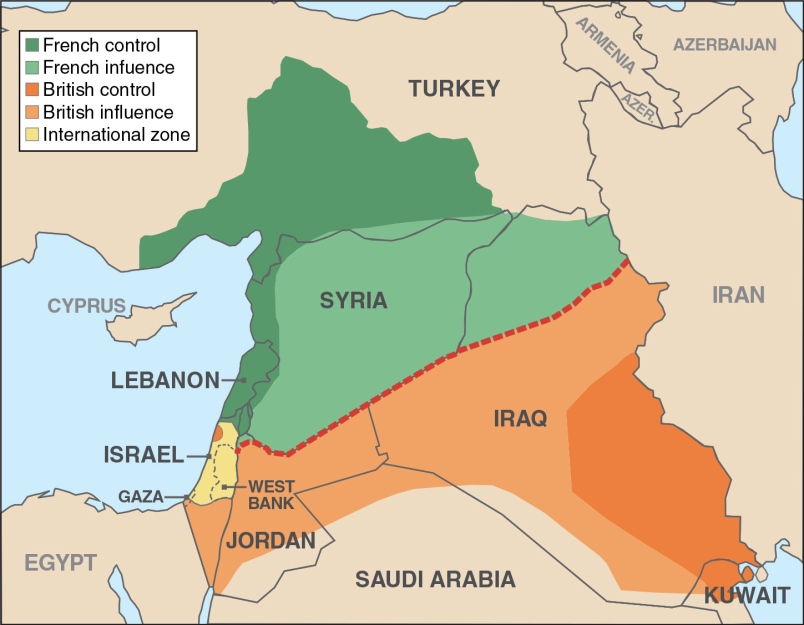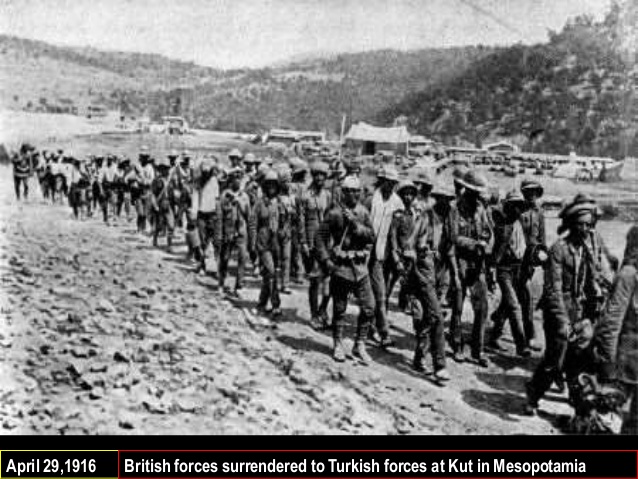Britain and France Carve Up The Middle East
One Problem: Ottoman Turks Winning the War
Special to The Great War Project.
(1-4 May) The British may have been defeated at Kut in Mesopotamia on the last day of April a century ago, but they are not defeated in the Middle East. At least that’s the way they see it.
Just three days before the British surrender in Kut — after a Turkish siege of 145 days — British and French diplomats, negotiating for months in Paris, sign a secret pact partitioning the Middle East after the war.
The document, known as the Sykes-Picot agreement, is the work of Sir Mark Sykes from Britain and Georges Picot of France. They hold private talks for months, negotiating the postwar partition of the Middle East.
“The diplomats,” writes historian Martin Gilbert, “were dividing up Asia Minor [much of the Middle East] in a secret agreement with France. In the Levant [present day Lebanon] France would control the Lebanese coast, with its capital at Beirut.”

The Middle East as seen through the Sykes-Picot agreement.
The agreement creates “an Arab sovereign state in Syria,” reports Gilbert, “based in Damascus, that would be under French protection.”
Britain would be sovereign over the port city of Haifa [now in northern Israel] and the crusader city of Acre [also in northern Israel], thus controlling the bay that would serve as the Mediterranean terminus for oil pipelines coming from Mesopotamia.
“Palestine,” reports Gilbert, “would be under the triple protection of Britain, France, and Russia.”
And finally, Gilbert observes, an Arab state under British protection would stretch from the Mediterranean to the Red Sea.
Of course this all depends on the Ottomans’ losing the war. Just now though, they are celebrating the great victory against the British at Kut…
…on the Tigris River a hundred miles south of Baghdad.
“More than 9,000 troops surrendered to the Turks on April 29th,” a century ago, according to Gilbert.
Nonetheless, in Britain the surrender at Kut comes as a great shock. “More men had surrendered to the despised Turk at Kut,” Gilbert writes, “than had surrendered to the Americans at Yorktown,” (a great victory for the Americans during their revolutionary war).
What’s more, this comes just four months after the Turks drive the British and allied troops off the Gallipoli peninsula. The British position in western Turkey and the Middle East is disastrous.
“Despite the fresh example of the catastrophe at Gallipoli,” writes historian Scott Anderson, “many senior British commanders simply couldn’t accept that they might lose to the ‘rabble’ of the Ottoman army once again.”
The next day the Turks begin a forced march of thousands of captured soldiers. Their destination is “distant Anatolia.”
A veritable death march is beginning.
Writes historian Gilbert, “The soldiers captured at Kut, nearly 12,000 in all, British and Indian alike, were marched northward without any concern whatsoever for their well-being, or for their helpless status as prisoners-of-war.”
Many of the captured soldiers are forced to walk barefoot after their boots are stolen. “Those who stumbled or fell were beaten with whips and sticks.”

Thousands to British and Indian soldiers on march from Kut to Baghdad.
Some British officers travel up the Tigris River by boat and manage to observe the march briefly. One writes later, “the eyes of our men stared from white faces drawn long with the suffering of a too tardy death, and they held out their hands towards our boat.”
There is nothing the observing British officers can do.
And what of the work of Sykes and Picot?
“Even the most starry-eyed imperialist had to recognize,” observes historian Anderson,
“there was something faintly ludicrous about Britain and France sitting around and divvying up the postwar Middle East at a time when, if not outright losing that war, they certainly weren’t winning it.”
